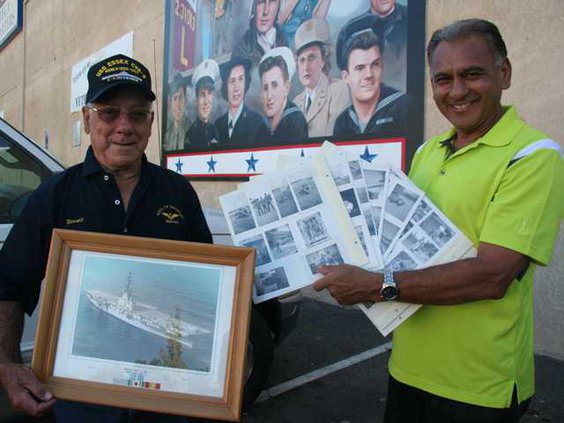The Manteca Mural Society’s next mural project will honor Korean War veterans.
A meeting is set for Thursday, Aug. 13, from 10 a.m., to noon at the American Legion Hall, 220 E. Yosemite Ave., to obtain input from those who served during the war. The society is seeking help to establish guidelines for the design of the Korean War Mural that will eventually go next to the World War II mural along with the Global War on Terror mural gracing the side of the Bedquarters building in downtown Manteca at Yosemite and Main.
Organizers are asking veterans to bring any photos they may have of the time period so they can be displayed and shared with the group. An open discussion will take place to determine what should be portrayed in the mural.
One of the Korean War veterans who will attend Thursday is Bennie Gatto.
Gatto served in the Navy from 1948 to 1956.
When he was discharged he had attained the rank of Ship Serviceman 2nd Class.
His first tour of duty was assignment to Moffet Field in the Bay Area.
It was there that the young Gatto got orders to participate in Operation Hay Lift.
The winter of 1949 was particularly severe in Colorado, Utah, and Arizona. Historical levels of snowfall stranded numerous cattle herds on open ranges.
Gatto was part of a crew that loaded hay bales onto planes and pushed them out one by one as the pilot flew 1,000 feet and lower above the ground.
“The planes were packed with hay,” Gatto recalled. “There was barely enough room for the pilot to make his way to the cockpit.”
Many cows were stranded in snow up past their bellies. Gatto noted there were several close calls of the heavy bales almost landing on cows. In one instance, the low flying aircraft came close to sticking a house.
When the Korean War broke out Gatto was assigned as part of the crew on transport planes that took troops to Korea.
He was transferred to Hawaii and eventually became part of the crew assigned to the aircraft carrier Essex.
The carrier held about 100 planes. On the first tour, the Essex did not operate with an angled deck for planes to take off from. The angled deck — now standard on aircraft carriers — was added during his second tour on the Essex while it was in dry dock.
He still recalls taking off one day while seated behind the pilot in a TBM torpedo plane and looking out a small window and watching the deck disappear under them as they became airborne after a slight dip over the ocean. Today jets are launched as opposed to the 1950s when propeller planes simply took off.
Gatto noted tours back them were nine months as opposed to the six months today.
That led to one of his most gut wrenching experiences.
When he departed for his first tour his daughter Karen was 9 months old. When he returned nine months later, he was eager to embrace his daughter who was then 18 months. Instead of hugging her father she pulled away crying not understanding who he was.
“That was rough,” Gatto said.
The second tour when he was in dry dock was better as he was able to spend time with his daughter.
Gatto is bringing various mementos of his service to the meeting.
Vietnam War veteran Ron Cruz, who is also a part of the mural society, is bringing photos from Bill Cabral’s collection. Cabral served in Korea as part of the Army.
The mural society noted:
The Korean War was the first military action of the Cold War.
There are still more than 7,000 U.S. soldiers missing in action.
California had the most veterans in the Korean War, 430,800.
54,200 American veterans gave their lives in Korea.
MASH (Mobile Army Surgical Hospitals) units were first used in the Korean War.
131 Medals of Honor were given during the Korean War.
The mural will cost the society $25,000 to complete. When it is finished the next mural will honor those who served in the Vietnam War with the fifth and final mural to grace the Bedquarters wall to honor those who served in World War I.
Honoring Korean War veterans
Mural society seeks input on Thursday





